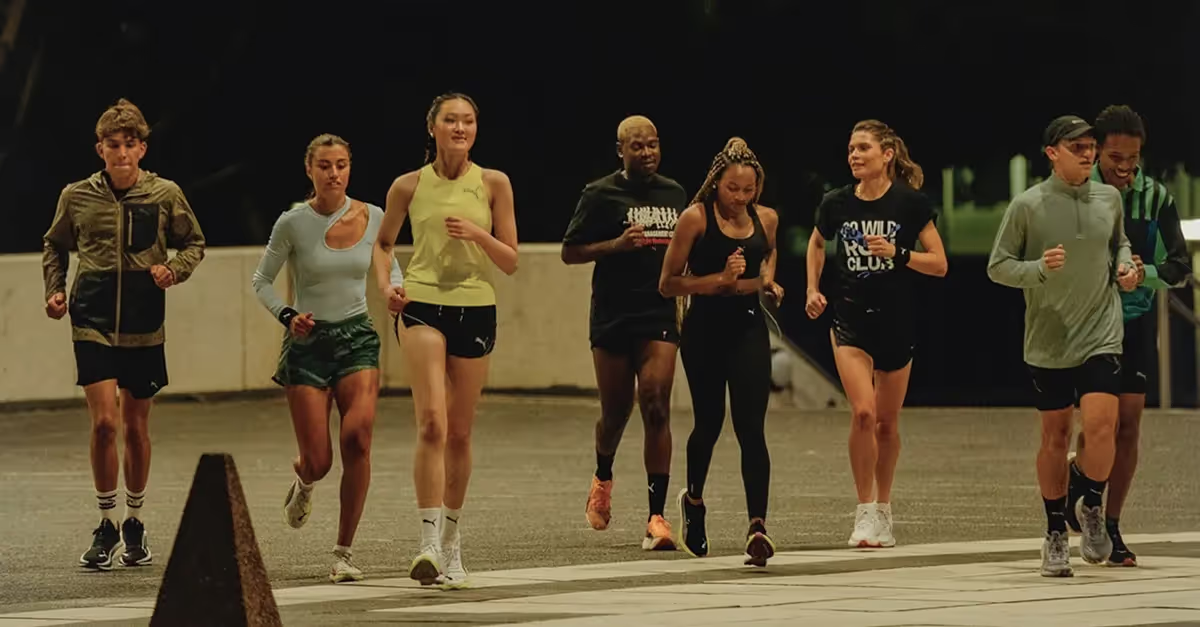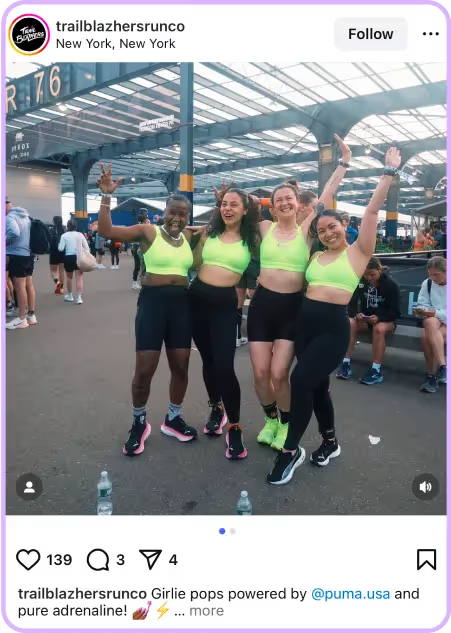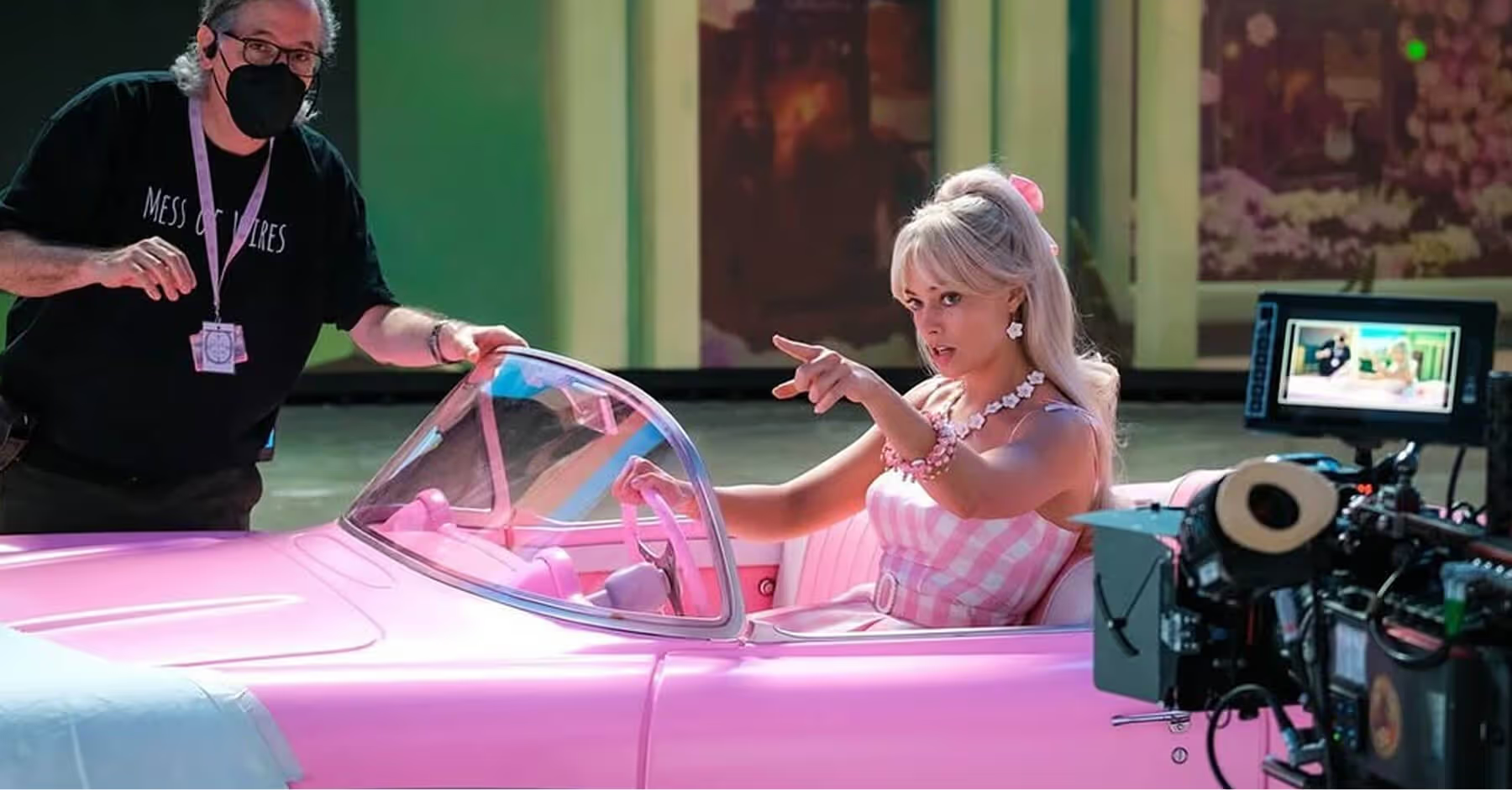How Running Clubs Make Authentic UGC To Build Brand Loyalty
Discover how running clubs bolster UGC and take community from the street to social.

They say when you hit a certain phase of life, you have no choice but to enter into one of the following camps: Gardening, reading, baking or running. These activities are meant to make us feel good, like we’re accomplishing something outside of our 9-to-5s. While all hobbies have their place (and dedicated communities on social media platforms), running marathons, RunTok and specifically run clubs are currently taking the world by storm.
Running clubs are more than just fitness groups. They are storytelling machines, powered by real people doing real things. And when brands tap into this ecosystem with care and authenticity, the result is a steady stream of relatable, high-performing content that deepens customer loyalty. But not all UGC is created equal. Some of the most compelling and authentic content comes from passionate communities with a shared purpose, like running clubs.
Key Takeaways:
- Authenticity over everything. Make the conscious effort to show up authentically in the communities that best align with your brand's values.
- Prioritize in-person activations. While a lot of the metaphorical legwork begins and ends online, it’s important to make your mark face-to-face.
- Jump on opportunities, or create your own. Play an active role in your community by tagging onto existing events or creating your own if you see a gap.
- UGC is your best friend. UGC from clubs feels trustworthy because it’s created by people who are genuinely involved, not incentivized influencers.
How Brands Can Authentically Embed Themselves in Fitness Communities
If there’s one thing we know to be true about social media users, it’s that they can smell inauthenticity from a mile away. This is especially accurate when it comes to brands trying to integrate themselves into conversations, trends or communities. If users feel like the brand is there solely to sell or contribute ‘corporate cringe’, it’s game over. And this holds true for the running and fitness community.
Brands can avoid the dreaded “silence, brand!’ by making connections, building community and inserting themselves where it makes sense. While not every brand needs to hop on the running hype bandwagon, it’s the perfect fit for many in the fitness space with opportunities to:
- Support local clubs with gear, event sponsorship or branded materials (without strings attached).
- Feature community stories across your brand channels. Spotlight real runners.
- Encourage UGC with branded hashtags, but don’t overly curate.
- Celebrate milestones. Recognize runners for personal achievements to deepen emotional ties.
- Show up in person. Sponsor meetups or send reps to support races. The real-life connection matters.
Brands that are ahead of the curve are taking their community-based marketing strategies to the next level by teaming up with other brands and run clubs to host or sponsor these types of events. The best way to integrate yourself into a community as strong as this one is by playing a role and being actively involved in it, both online and off.
How Brands Work With Running Clubs
It’s easy to say all kinds of brands are doing it right when it comes to partnering with run clubs and fitness communities, but what does that actually look like in practice? The following brands are behemoths in the fitness and wellness industry, not just because of the products they sell or the popularity they’ve gained, but because of how they show up for their communities every single day.
The following brands not only capitalize on opportunities they see in the run club community, but they also create their own.
Under Armour
Under Armour might not be the first brand that comes to mind when you think about running, but not because of a lack of product or quality. To showcase what they really offer, the brand took it upon themselves to sponsor a running team, Mission Run Dark Sky, a club full of elite athletes who compete professionally in races all over the world.
While Mission Run Dark Sky might be a slightly more serious running club than the average runner is used to, Under Armour saw an opportunity to show consumers what makes their products great instead of just telling them. And now, they have a community of athletes who proudly represent them at every opportunity.

Nike
The Nike Run Club app is one of the most used apps by runners who are either just breaking into the running world or enjoy connecting with a global community. The app is especially great because it acts as a welcoming space for all types of runners and allows people to join a community even if they don’t necessarily feel comfortable meeting up in person.
Nike understands that different types of runners need (and deserve) different types of spaces, and that doesn’t mean they shouldn’t have a community to be a part of and show up for every day.

Brooks Running
Every year, Brooks partners with Paragon Sports to host a Pride Run & Chug. This sold-out event in New York supports LGBTQ+ rights and is one of the largest community-building events in the city. Runners travel from all over the country to participate and show up for what they believe in.
By hosting this run annually, Brooks has established themselves as a leader of this specific community and of Pride Month marketing in general. They have created a safe environment for all runners, making the Pride Run & Chug an event people are proud to attend and Brooks a brand they are even prouder to promote all year long.

Puma
TrailblazHers Run Co. is a Boston-based running crew grounded in diversity and sisterhood. Its main sponsor and partner is Puma. This duo is a match made in heaven, as both groups are dedicated to wellness, hard work and empowering women to show up for themselves in traditionally male-dominated spaces.
The pair also hosts an annual Bra Run that, despite the name, is open to anybody and everybody, even non-runners. Puma does an incredible job of shining the spotlight on the TrailBlazHers, both at this event and as a part of their greater sponsorship, showing the sheer amount of respect and care that goes into this partnership as a whole.

How Running Clubs Inspire a Stream of UGC
As you can see from the examples above, brands collaborating with running clubs lead to a UGC goldmine. Running clubs naturally foster environments where content creation thrives through things like:
- Shared achievements: Members document personal records, group races and weekly runs.
- Visual rituals: Sunrise runs, sweaty selfies, post-run coffee meetups — all make for engaging, visual content.
- Community motivation: Encouragement from peers drives more frequent social sharing.
The biggest community and UGC driver is obviously the in-person events and activations. Running creators are naturally going to post about these events before, during and after to keep their following in the know. This allows brands to have organic content to use to promote an upcoming event or showcase how a past event performed to build anticipation.
But the UGC train doesn’t stop running when the race does. Partnering with running clubs basically guarantees a steady stream of user-generated content via selfies, Reels, Strava posts and even sponsored club shirts or brand tags. All types of short-form video can and will be used to spotlight community members and their stories, their runs and their transformations.
What Makes Running Club UGC So Successful?
Unlike influencer content, which can feel transactional or overly curated, running club UGC is rooted in community pride and real-world accomplishment. That’s what makes it so compelling. Authenticity in UGC stems from emotion, context and spontaneity. Running club content checks all these boxes:
- It’s unfiltered and real. Blurry photos, sweaty faces and candid smiles make it feel human.
- It’s inclusive. Everyone’s welcome on the feed, from first-timers to sub-3-hour marathoners.
- It’s identity-driven. Club members often see the group as part of who they are, not just something they do.
This type of content doesn’t just showcase a product or a brand, it tells a story of belonging, progress and joy. For a brand that aligns itself with these stories, the association can be incredibly powerful.
Turn Running Club Members into Brand Ambassadors
Take your UGC to the next level by creating long-lasting partnerships with the people who already authentically represent your brand. Brand ambassadors are the perfect type of influencer to work with fitness and running brands because they are often already genuinely invested in what your brand stands for and use your products to reflect their daily life, values and activities.
By already integrating with running clubs, it makes sourcing a great brand ambassador, whether they be nano, micro or macro influencers, much easier. You already have the connection, and you see the drive, making the partnership a natural fit for both parties.





